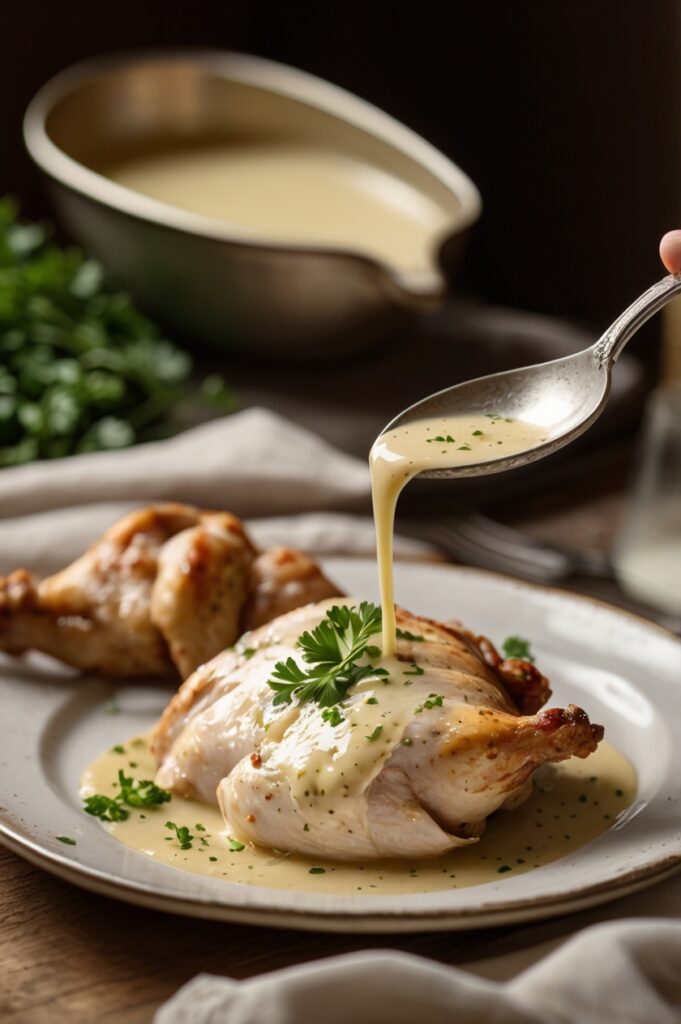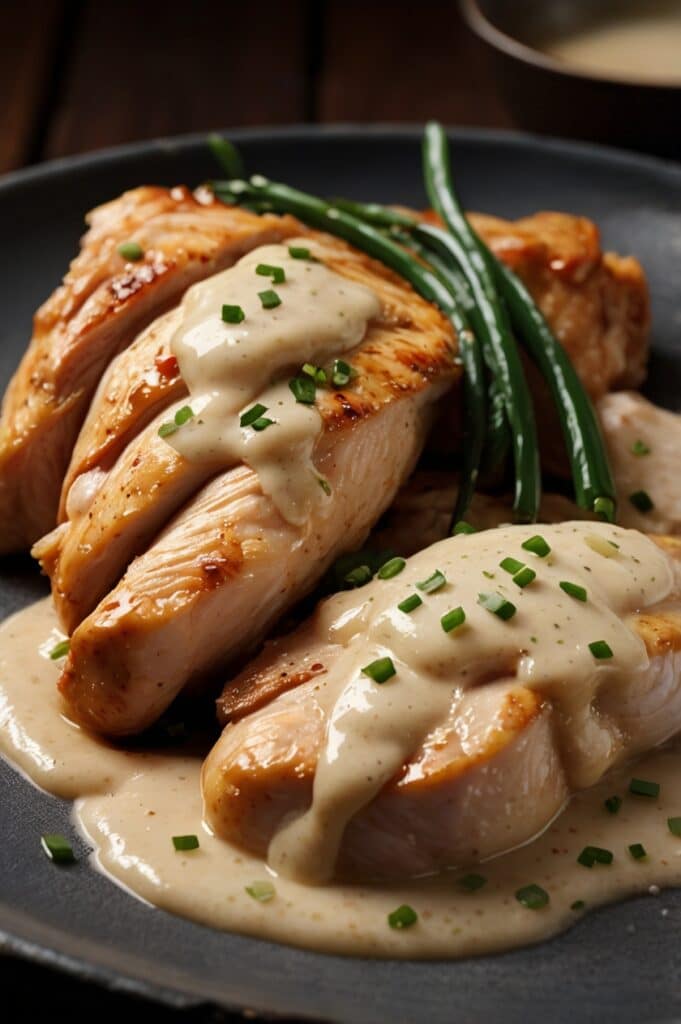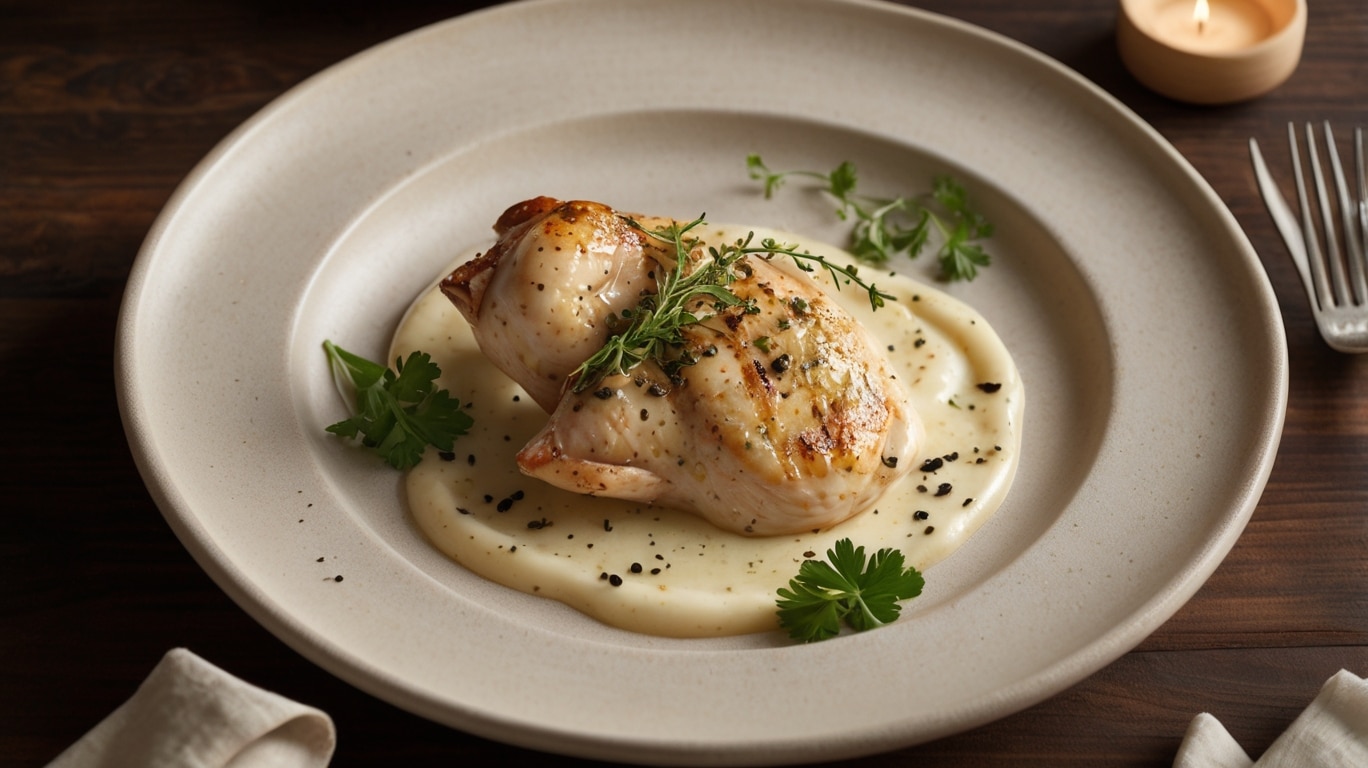There’s this dish my grandmother used to make—creamy, garlicky, and so ridiculously comforting it made the whole house smell like Sunday. Didn’t matter if it was Tuesday. The sauce clung to the back of a spoon like velvet. The chicken? Fork-tender, almost embarrassingly juicy. That dish stuck with me. And now, I’m giving it to you—with a few tricks I’ve learned in professional kitchens.
Creamy Garlic Chicken is a skillet classic with chef-level charm.
It’s humble at first glance—just chicken, garlic, cream, right? But done right, it’s a symphony. There’s technique behind that simplicity. The chicken is seared just ’til the fat sings. The garlic is sautéed slow, coaxed into sweetness. And the sauce—it’s not just cream dumped in—it’s built.
Ingredients & Substitutions
Creamy Garlic Chicken needs:
- Chicken thighs, bone-in, skin-on – 4 to 6 pieces.
You can use boneless breasts, but they dry quicker—so brine ’em if you go that route. Thighs stay juicy, even if you’re distracted by your kid screaming mid-sauté. - Garlic cloves – 10 to 12, peeled.
Yes, that’s a lot. And yes, use fresh—not the jarred stuff, which tastes like sour regret. - Heavy cream – 1 cup.
You could use half-and-half in a pinch, but it’ll thin out the sauce. Full-fat coconut milk? Works for dairy-free, adds a subtle sweetness. - Chicken stock – ½ cup.
Preferably homemade or low-sodium. Store-bought cubes will work, but dilute or it’ll punch you with salt. - Parmesan – ¼ cup, grated.
Adds depth and umami. Avoid the powdery stuff in the green can unless it’s an emergency. - Butter – 2 tbsp.
For searing and richness. Ghee works too. Don’t skip the fat here. - Olive oil – 1 tbsp.
Helps prevent butter from burning during sear. Neutral oil is okay but olive oil adds a subtle fruitiness. - Fresh thyme – 2 sprigs (or 1 tsp dried)
Dried thyme’s fine, just rub it between your fingers first to wake it up. - Salt & black pepper – to taste
Always taste the sauce before final seasoning. Cream dulls salt—you’ll need more than you think.

Step-by-Step Instructions
Creamy Garlic Chicken starts in a hot pan.
Heat butter and olive oil together until they foam and smell nutty. If the pan’s too cold, your chicken steams. Too hot? You’ll burn the butter. Medium-high heat is your sweet spot.
Creamy Garlic Chicken sears chicken skin-side down first.
Don’t flip too early—let the skin release naturally. That crispness is flavor. About 5–6 mins per side until golden and mostly cooked through. Remove and set aside.
Creamy Garlic Chicken demands patience with garlic.
Lower heat. Add whole cloves. Let ‘em sizzle gently in the leftover fat. They’ll go from harsh to mellow, kinda nutty. Don’t rush or they’ll scorch and turn bitter. Think golden, not brown.
Creamy Garlic Chicken builds sauce in layers.
Deglaze with stock—scrape up every crispy brown bit (called fond) like it owes you rent. Add cream, bring it to a soft simmer. Never boil cream. It’ll split and cry.
Creamy Garlic Chicken finishes strong.
Return chicken to pan. Nestle it into the sauce, skin-up so it stays crispy. Toss in thyme. Let everything bubble gently for 10 mins. Sauce thickens, garlic melts. Parmesan goes in last—stir gently to avoid clumping.
Creamy Garlic Chicken should nap, not swim, in sauce.
If it’s too thick, splash in a bit more stock. If it’s too thin, simmer uncovered a couple more mins. Keep tasting.
Cooking Techniques & Science
Creamy Garlic Chicken relies on the Maillard reaction.
That beautiful brown crust on your chicken? It’s not just pretty—it’s flavor science. Proteins and sugars reacting under heat. Searing creates that, and it only happens in dry, hot pans. Wet chicken won’t brown—it’ll sulk and steam.
Creamy Garlic Chicken leans on emulsification.
Cream, stock, cheese—they wanna separate. Gentle heat, slow incorporation, and constant motion bind it all together. Stir often, but don’t whisk like you’re angry.
Creamy Garlic Chicken elevates garlic by confit-style cooking.
Slowly toasting whole cloves makes them sweet, soft, and complex. Kinda like roasting, but quicker. You’re mellowing the sulfurous bite into cozy richness.
Creamy Garlic Chicken thrives in cast iron.
Cast iron holds heat evenly and helps build fond. Nonstick’s okay, but you’ll lose the crust. Stainless steel works too—just watch the temperature closely.
Serving & Pairing Suggestions
Creamy Garlic Chicken loves mashed potatoes.
Classic, buttery mash soaks up every drip of that luscious sauce. Rice or orzo works too—something starchy and soft.
Creamy Garlic Chicken plays well with green beans or broccolini.
You need something crisp and fresh to cut through the richness. A lemony arugula salad? Even better.
Creamy Garlic Chicken belongs on warm plates.
Warm the plates before serving. Cold plates kill sauce. Garnish with a sprig of thyme or extra roasted garlic for drama.
Creamy Garlic Chicken begs for a glass of Chardonnay.
Something oaky and full-bodied balances the cream. Or go dry Riesling if you want something snappy.
Creamy Garlic Chicken doesn’t need much else.
Serve with crusty bread, maybe a little flaky salt on top. That sauce? Spoon-licking legal.

Conclusion
Creamy Garlic Chicken is a masterclass in balance.
Crispy meets silky. Rich meets mellow. Rustic, but refined. This isn’t just dinner—it’s the kind of food that shuts people up mid-bite.
Creamy Garlic Chicken teaches you patience and precision.
Letting garlic soften, waiting for the sauce to thicken just right—those moments separate good from unforgettable.
Creamy Garlic Chicken rewards the cook who pays attention.
Taste constantly. Adjust. Trust your instincts. You’ll know when it’s right because you’ll want to drink the sauce straight.
FAQs
Can I make Creamy Garlic Chicken ahead of time?
Yes, but reheat gently on the stove with a splash of stock or cream. Microwaves ruin the sauce texture.
What if I don’t have heavy cream?
Use full-fat coconut milk or evaporated milk. Greek yogurt is too tangy unless cut with milk.
Can I use garlic paste instead of cloves?
Please don’t. You need the texture and transformation of whole cloves cooking in oil.
How do I keep the sauce from curdling?
Don’t boil the cream. Simmer gently and add cheese off the heat or at the very end.
What herbs work if I don’t have thyme?
Fresh rosemary or tarragon. Dried oregano in a pinch. Just use sparingly—thyme’s subtle; others are loud.

Olivia P. is a seasoned food blogger at Tastywink, sharing delicious, easy-to-follow recipes inspired by him passion for home cooking. With years of culinary blogging experience, he brings flavor, creativity, and a personal touch to every dish.
